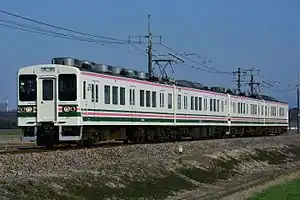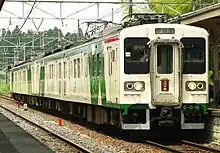| 107 series | |
|---|---|
 A pair of 107-100 series sets on the Ryomo in March 2016 | |
| In service | 1988 – October 2017 |
| Manufacturer | JR East |
| Built at | Koriyama, Niitsu, Nagano, Omiya, Oi, Ofuna |
| Replaced | 165 series |
| Constructed | 1988–1991 |
| Entered service | 1988 |
| Scrapped | 2013– |
| Number built | 54 vehicles (27 sets) |
| Number in service | None |
| Number scrapped | 42 vehicles (21 sets) |
| Successor | 205 series |
| Formation | 2 cars per trainset |
| Operators | JR East |
| Depots | Oyama, Takasaki |
| Specifications | |
| Car body construction | Steel |
| Car length | 20,000 mm (65 ft 7 in) |
| Width | 2,800 mm (9 ft 2 in) |
| Doors | 3 pairs per side |
| Maximum speed | 100 km/h (60 mph)[1] |
| Traction system | Resistor control |
| Electric system(s) | 1,500 V DC |
| Current collector(s) | Overhead catenary |
| Safety system(s) | ATS-P[2] |
| Track gauge | 1,067 mm (3 ft 6 in) |
The 107 series (107系) was a DC electric multiple unit (EMU) train type that was operated on local services by East Japan Railway Company (JR East) in Japan from 1988 to 2017.
Variants
- 107-0 series: 8 x two-car sets formerly used on Nikko Line services (until March 2013)
- 107-100 series: 19 x two-car sets formerly used on Ryomo Line, Agatsuma Line, Joetsu Line, and Shinetsu Main Line services
Design
The 107 series trains were the first EMUs to be built by JR East following the splitting of the former Japanese National Railways (JNR), and reused components such as bogies and air-conditioning units from withdrawn 165 series EMUs.[3]
107-0 series
Eight two-car sets (sets N1 to N8) were allocated to Oyama Depot for use on Nikko Line local services.[2] The units entered service on 1 June 1988, and were originally painted in a livery designed by a Tochigi high school student, featuring large green "N" logos on a cream base. A new "retro" livery of brown and cream was introduced from March 2009, with the last train in original livery running until 17 January 2010.[4] The 107-0 series sets were withdrawn from service on the Nikko Line on 15 March 2013.[5]
 107-0 series set N8 in original Nikko Line livery in June 2008
107-0 series set N8 in original Nikko Line livery in June 2008 Interior view in July 2010
Interior view in July 2010 107-0 series set N1 in revised Nikko Line livery in June 2009
107-0 series set N1 in revised Nikko Line livery in June 2009
Formation
The two-car 107-0 series trainsets, N1 to N8, were formed as follows with one motored car.[2]
| Designation | Mc | Tc' |
|---|---|---|
| Numbering | KuMoHa 107 | KuHa 106 |
Fleet history
The build details and fleet histories for the eight 107-0 series sets are as follows.[6]
| Set No. | Factory | Date delivered | Date withdrawn |
|---|---|---|---|
| N1 | Ofuna | 16 May 1988 | 5 June 2013 |
| N2 | Omiya | 19 May 1988 | |
| N3 | Oi | 1 July 1988 | 29 June 2013 |
| N4 | Ofuna | 16 August 1988 | 5 June 2013 |
| N5 | Omiya | 20 August 1988 | 29 June 2013 |
| N6 | Oi | 19 September 1988 | |
| N7 | Niitsu | 27 October 1988 | |
| N8 | Ofuna | 30 September 1988 | 5 June 2013 |
107-100 series
Nineteen 2-car sets (R1 to R19) were delivered to Takasaki Depot between November 1988 and February 1991 for use on Ryomo Line, Agatsuma Line, Joetsu Line, and Shinetsu Line local services. The livery is all-over cream with green and pink lining. Sets from R6 onwards have no door pocket windows.[3]
 107-100 series set R2 at Yokokawa Station in April 2007
107-100 series set R2 at Yokokawa Station in April 2007 107-100 series set R10 (with no door pocket windows) at Kuroiso Station in August 2009
107-100 series set R10 (with no door pocket windows) at Kuroiso Station in August 2009 Interior view of a 107-100 series set
Interior view of a 107-100 series set
Formation
The two-car 107-100 series trainsets, R1 to R19, are formed as follows with one motored car.[2]
| Designation | Mc | Tc' |
|---|---|---|
| Numbering | KuMoHa 107-1xx | KuHa 106-1xx |
Fleet history
The build details and fleet histories for the 19 107-100 series sets are as follows.[6]
| Set No. | Factory | Date delivered | Date withdrawn | Remarks |
|---|---|---|---|---|
| R1 | Ofuna | 30 November 1988 | 1 November 2017[7] | |
| R2 | Omiya | 14 July 2016 | ||
| R3 | Oi | 1 February 1989 | 21 April 2017 | |
| R4 | Omiya | 28 February 1989 | 21 April 2017 | |
| R5 | Niitsu | 23 March 1989 | 21 April 2017 | |
| R6 | Omiya | 11 September 1989 | ||
| R7 | Oi | 30 September 1989 | 3 October 2017[7] | Resold to Joshin Electric Railway |
| R8 | Niitsu | 20 October 1989 | ||
| R9 | Nagano | 21 April 2017 | ||
| R10 | Omiya | 29 November 1989 | 22 June 2017 | |
| R11 | Ofuna | 27 December 1989 | ||
| R12 | Omiya | 28 February 1990 | 14 July 2016 | |
| R13 | Oi | 23 February 1990 | ||
| R14 | Ofuna | 29 March 1990 | ||
| R15 | Koriyama | 6 March 1990 | 12 October 2017[7] | Resold to Joshin Electric Railway |
| R16 | Omiya | 10 September 1990 | ||
| R17 | Oi | 12 November 1990 | 22 June 2017 | |
| R18 | Niitsu | 26 December 1990 | 14 July 2016 | |
| R19 | Omiya | 1 March 1991 | 14 July 2016 |
Withdrawal and resale
107-0 series
The Nikko Line 107-0 series fleet was withdrawn and replaced by four refurbished four-car 205 series EMUs from the start of the revised timetable on 16 March 2013.[5]
107-100 series
The 107-100 series trainsets were gradually replaced by reformed four-car 211 series EMUs from 2016, and from the start of the 4 March 2017 timetable revision, were removed from use on the Joetsu Line (except for between Takasaki and Shin-Maebashi), Shinetsu main Line, and Agatsuma Line, with one pair of sets remaining in use on the Ryomo Line.[5] By 1 July 2017, eight sets remained on the books, with just two of these, R7 and R8, actually operational.[5] The last remaining sets were withdrawn from service in late September 2017,[8] with a few special runs in early October held to mark their withdrawal;[9] following this, the 107 series was officially withdrawn.
Resale
Six two-car sets were scheduled to be resold to the Joshin Electric Railway in Gunma Prefecture.[8]
12 vehicles were transferred to the Joshin Electric Railway;[10] the first two-car train entered service on 10 March 2019.[11]
 Jōshin Dentetsu 700 series in July 2019
Jōshin Dentetsu 700 series in July 2019
References
- ↑ Jēāru zensharyō handobukku: Rail Magazine 2009 JR全車輌ハンドブック2009 (JR Rolling Stock Handbook 2009). Japan: Neko Publishing. 2009. ISBN 978-4-7770-0836-0.
- 1 2 3 4 5 6 7 8 JR電車編成表 2009夏 [JR EMU Formations – Summer 2009]. Japan: JRR. June 2009. pp. 38, 59. ISBN 978-4-330-06909-8.
- 1 2 107系100番台 風前の灯 [107-100 series hanging by a thread]. Japan Railfan Magazine (in Japanese). Vol. 57, no. 677. Japan: Koyusha Co., Ltd. September 2017. pp. 76–77.
- ↑ 日光線107系0番代 従来デザイン車運行終了 [End of original livery Nikko Line 107-0 series]. Tetsudo Hobidas (in Japanese). Japan: Neko Publishing Co., Ltd. 13 January 2010. Archived from the original on 24 July 2017. Retrieved 24 July 2017.
- 1 2 3 4 日光線用107系が営業運転を終了 [Nikko Line 107 series withdrawn from service]. Japan Railfan Magazine Online (in Japanese). Japan: Koyusha Co., Ltd. 16 March 2013. Retrieved 1 April 2013.
- 1 2 Togo, Shibata (November 2017). 機器流用車の現状 [Current state of trains reusing old equipment]. Japan Railfan Magazine (in Japanese). Vol. 57, no. 679. Japan: Koyusha Co., Ltd. p. 69.
- 1 2 3 JR車両のうごき [JR rolling stock changes]. Tetsudo Daiya Joho Magazine (in Japanese). Vol. 47, no. 407. Japan: Kotsu Shimbun. March 2018. p. 103.
- 1 2 「107系」第3の人生は上信で JR東が有償譲渡へ [107 series to spend third life on Joshin – To be resold by JR East]. Jomo Shinbun News (in Japanese). Japan: Jomo Shinbun. 29 August 2017. Archived from the original on 10 November 2017. Retrieved 30 August 2017.
- ↑ 吾妻線・上越線で団体臨時列車『ありがとう107系』運転 [Special "Thank you 107 series" charter train running on the Agatsuma and Jōetsu Lines]. Japan Railfan Magazine Online (in Japanese). Japan: Koyusha Co., Ltd. 2 October 2017. Archived from the original on 30 August 2017. Retrieved 10 November 2017.
- ↑ "2017年に引退したJR東日本107系が群馬県の私鉄で第二の人生...上信電鉄700形 3月10日から運行" [JR East 107 series retired in 2017 has a second life on private railways in Gunma Prefecture... Joshin Dentetsu 700 series operated from March 10]. response.jp (in Japanese). IID, Inc. 7 March 2019. Archived from the original on 5 December 2019. Retrieved 5 December 2019.
- ↑ "上信電鉄700形が営業運転を開始" [Joshin Electric Railway 700 series starts commercial operation]. Japan Railfan Magazine Online (in Japanese). Japan: Koyusha Co., Ltd. 11 March 2019. Archived from the original on 14 March 2019. Retrieved 5 December 2019.
External links
- JR East 107 series Archived 20 February 2012 at the Wayback Machine (in Japanese)